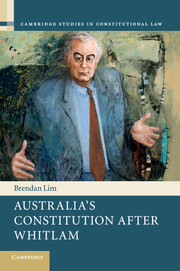7 - Conclusion
Published online by Cambridge University Press: 06 April 2017
Summary
Books often read as though they were called forth whole and fully formed, implicitly inviting readers to imagine that the finished product was not the result of agonising choices and repeated changes of heart and mind. For a brief moment, I am going to lift that particular curtain to emphasise the different directions in which this concluding chapter might have taken the book.
I asked several people for advice about how to conclude. There were different views. On one view, the concluding chapter needed to confront the question of how to avoid repeating 1975, or at least offer a reappraisal of the unresolved disputes of 1975. In other words, having set out to ask new questions about the constitutional crisis, I should turn my answers back on the standard questions and use the concluding chapter to engage in those well-rehearsed debates. On another view, I should look not backwards but forwards. I should identify the potential pressure points at which it might become important to attribute some meaning or authority to the 1975 precedent, and I should make predictions or offer guidance about how events might or should play out. What would or should happen today, for example, if the Senate withheld supply or if the government made a patently transformative judicial appointment?
Others recommended against anything so prescriptive and thought that I should use the concluding chapter as an opportunity to revisit and meditate upon the most important problems that animated or emerged from the book. There were, however, very different views about what those ‘important’ problems were. For some, they were the large, structural questions about relative concentration and diffusion of institutional power, or the theoretical debates about informal constitutional change. For others, they were the potential comparative implications of the work for studies of the British and American models of constitutionalism. Yet another view suggested that I should sketch out the doctrinal implications of the thesis. How might constitutional doctrine be explained or justified in light of my account? What does the book say about how the Court should decide constitutional cases?
- Type
- Chapter
- Information
- Australia's Constitution after Whitlam , pp. 232 - 239Publisher: Cambridge University PressPrint publication year: 2017

